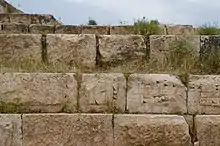Jerwan
Jerwan is a locality north of Mosul in the Nineveh Province of Iraq. The site is clear of vegetation and is sparsely settled.
 Shown within Iraq | |
| Location | Ninawa Governorate, Iraq |
|---|---|
| Coordinates | 36°40′11″N 43°23′37″E |


The site is famous for the ruins of an enormous aqueduct crossing the Khenis River, constructed of more than two million dressed stones and using stone arches and waterproof cement.[1] Some consider it to be the world's oldest aqueduct,[2] predating anything the Romans built by five centuries.
The Aqueduct of Jerwan
The aqueduct is part of the larger Atrush Canal built by the Assyrian king Sennacherib between 703 and 690 BC to water Ninevah's extensive gardens,[3] with water diverted from Khenis gorge, 50 km to the north.
An inscription on the aqueduct reads:
 Jerwan Aqueducts"Sennacherib king of the world king of Assyria. Over a great distance I had a watercourse directed to the environs of Nineveh, joining together the waters.... Over steep-sided valleys I spanned an aqueduct of white limestone blocks, I made those waters flow over it."[4]
Jerwan Aqueducts"Sennacherib king of the world king of Assyria. Over a great distance I had a watercourse directed to the environs of Nineveh, joining together the waters.... Over steep-sided valleys I spanned an aqueduct of white limestone blocks, I made those waters flow over it."[4] Jerwan Aqueducts
Jerwan Aqueducts
Some scholars[5][6] believe the legends of the Hanging Gardens of Babylon were actually Sennacherib’s extensive gardens in Nineveh,[7] not Babylon.[8]
Further reading
- Documents from Jerwan by The University of Chicago
- Reconstruction of the Jerwan Aqueduct
- Richard David Barnett, Sculptures from the north palace of Ashurbanipal at Nineveh (668-627 B.C.), British Museum Publications Ltd, 1976









References
- T Jacobsen and S Lloyd, Sennacherib's Aqueduct at Jerwan (1935); Reade, Studies in Assyrian Geography, Revue d'Assyriologie 72 (1978); Channel 4 tv programme "Secret History: Finding Babylon's Hanging Garden, 24th November 2013
- AH Layard, Discoveries in the Ruins of Nineveh and Babylon, (1853).
- The Oldest Intact Aqueduct in the World
- photograph of Sennecherib's inscription.
- Wolfram von Soden, The Ancient Orient: An Introduction to the Study of the Ancient Near East. (Grand Rapids: Erdman's Publishing Company, 1985). (pp.58)
- Stephanie M. Dalley, Hanging Garden of Babylon: an elusive World Wonder traced. (Oxford University press, 2013).
- Thorkild Jacobsen and Seton Lloyd.Sennacherib’s Aqueduct at JerwanOriental Institute Publications (OIP) OIP 24.
- Stephanie Dalley (1993). "Ancient Mesopotamian Gardens and the Identification of the Hanging Gardens of Babylon Resolved". Garden History 21: 7.